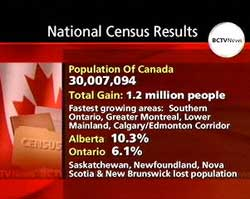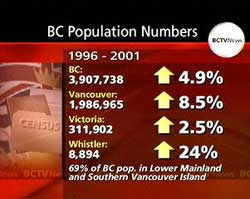Greater Vancouver - Statistics

|
|
Graphics from canada.com |
In the most recent national census in 2001, Canada finally passed the 30 million mark in population. The fastest growing areas were Southern Ontario, Greater Montreal, Lower Mainland, and the Calgary/Edmonton Corridor.
Southern Ontario includes Toronto with four million people alone. The rest of Southern Ontario includes other cities like Brampton, Mississauga, Hamilton, London, and Waterloo.
Greater Montreal is made up of Montreal and its surrounding suburbs. Apparently, the uncertainty of Quebec sovereignty has not deterred people from moving to Montreal.
Lower Mainland is the southwest corner of British Columbia. It includes Vancouver and its suburbs. Also, it includes the farming communities of the Fraser Valley and the popular ski resort of Whistler.
The Calgary/Edmonton corridor is the area of land that includes Calgary and Edmonton plus all the land in between them. The two cities are only about 2-3 hours apart and many people enjoy living in the rural communities between the two big prairie cities.

|
|
Graphics from canada.com |
The province of British Columbia has enjoyed steady growth for many years now. Most of its newcomers are immigrants from a variety of Asian countries like China, Korea, India, and the Phillipines.
Greater Vancouver population is just under two million people, but its population is expected to double within the next two decades. The City of Vancouver itself has a population just over 500,000. So one-quarter of Greater Vancouver's population lives in the city itself. About one-third of the population lives in the fast-growing Northeast Sector that includes Coquitlam, Port Coquitlam, Port Moody, Pitt Meadows, and Maple Ridge. Other areas in the province, like the capital, Victoria, and the ski resort of Whistler have also experienced amazing growth.